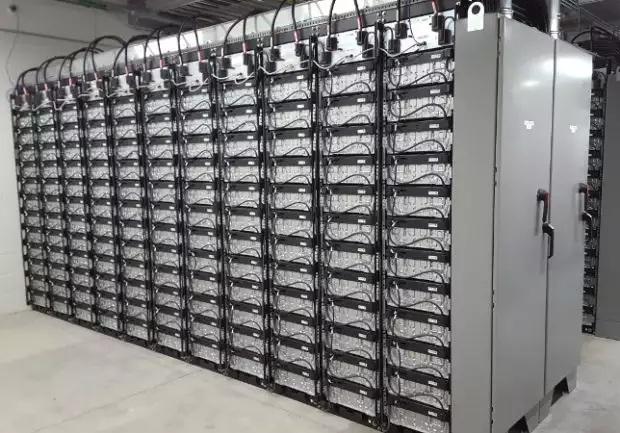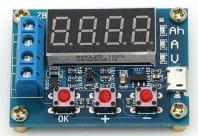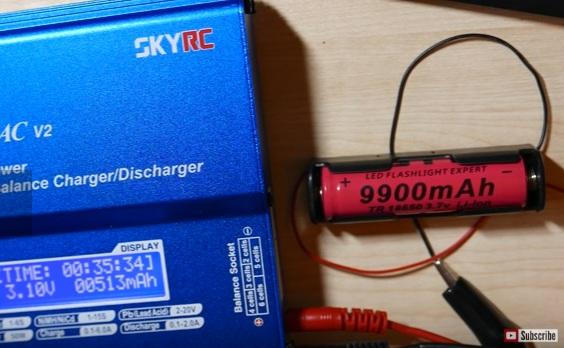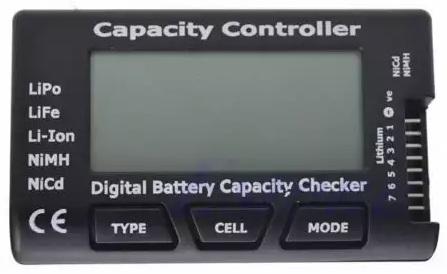Solar battery on the balcony: the use of batteries
Hello geektimes! This article is a continuation of the previous part , about the experience of installing a 100-watt solar battery on the balcony. In the original version, a DC-DC converter was connected to the battery, from which various home devices could be charged. The next step was to add the possibility of accumulating energy for use in the evening and at night.

What happened, the details under the cut.
As mentioned in the previous section , despite the non-optimal installation angles and a small number of panels (2x50W), the solar panel works in principle. But then the question arises as towhat to do with this energy.
There are several options:
')
1) Use energy only as needed, for example, to charge the tablet. In terms of efficiency, this is the worst option - during the day when it is light, everything is at work, and using a 100-watt panel to charge the phone is too redundant - the solar panel costs 95% of the day off.
Optionally, you can simply connect a ready USB power bank, for example, at 10000mAh. It will work, but the solution is, firstly, uninteresting in terms of creativity, and secondly, the maximum power for USB charging is about 10W, i.e. already for a 50-watt panel, most of the energy will be wasted (although it will do for cloudy weather). And thirdly, the choice of devices connected via USB is not that great.
2) Supply energy to the grid (grid-tie technology) so that it is used by other electrical appliances. In principle, this is a modern and most used option in private homes. Very convenient, nothing is lost, all that is generated is given to the network, the number of required components is minimal. Alas, it didn’t work for my balcony - the recommended power of the panels for the normal operation of the inverter was 200W, and it was no longer included in the budget to increase the number of panels by 2 times. And there was no big economic sense - the windows face east, and direct sunlight hits them only in the morning until 11-12 am.
3) accumulate energy in the battery. Since the first two methods did not come up, this is the only thing left to do.
Pluses are obvious:
- Ability to use stored energy at any time.
- The ability to connect to the battery a more powerful load (for example, an electric drill will not work from the solar panel, and it will be easy from the battery).
- Ability to use a variety of devices designed for 12V - LED lamps, charging for a laptop, etc.
- Optional ability to connect the inverter to 220V, and as a bonus, the appearance in the house of a backup power source in case of power failure.
The minus is also obvious: the batteries in such systems are the most short-lived, very expensive, and environmentally harmful component. But on the contrary, we will turn the last minus into a plus - the batteries can be reused (about the same as rumored to do Musk in their Tesla Powerwall).
There are two types of useful batteries for us:
- Lead and their varieties: gel, alkaline, automobile, from UPS, etc. Cheap, fire safe, but this is where the advantages end. The number of cycles is small, the weight and dimensions are inconvenient. At the same time, it is the cheapest and easiest option - and it is cheap and simple, and it’s impossible to "mess up" here. The price of the charge controller on eBay is less than 1000r, the battery can be bought at any nearest store.
- Lithium . There are many different kinds of them, and it is much easier to get confused.
"Traditional" lithium-ion: voltage 3.7V, maximum charging voltage 4.2V, minimum voltage 3.0V. They do not like recharging (the number of cycles decreases dramatically), and hypothetically (in the absence of protection and violation of the operating mode) are fire-dangerous.
Lithium-iron-phosphate (LiFePO4): voltage 3.2V, maximum charging voltage 3.65V, minimum voltage 2V. Judging by the tests, fire-safe, even with short-circuit conditions, they only stink, but do not burn.
Lithium-titanate (Li4Ti5O12): 2.4V voltage, maximum charging voltage 2.85V, minimum voltage 1.8V. Fireproof plus have a large number of cycles (according to different sources, from 7000 to 15000), which makes them almost "eternal". The downside is that the voltage is minimal, and it's not easy to buy them.
A more detailed description of the different views, with their pros and cons, can be read here . Obviously, each type of battery needs its own charge mode, and in general, chargers are incompatible with different types of cells, if there is no choice in the settings. Attempting to charge LiFePO4 with a regular lithium charger to 4.2V will simply ruin the battery.
As a result, of all the variety, it was decided to stop at the simplest and proven option: lithium-ion batteries of the form factor 18650 .
- This is the most popular form factor, such batteries are used in laptops, screwdrivers, powerbank-ah, etc.
- Such batteries are easy to get, for example, from used laptop batteries, in which only a few cells usually fail, and the rest are quite efficient.
- As a consequence of the previous paragraph, reusing batteries, we not only do not harm the environment, but on the contrary, we give elements a second life.
Here you can look at the testing of such batteries in detail:
Elements 18650 is easy to buy and new, and when buying in large quantities, the price of a battery can be less than a dollar a piece. This allows enthusiasts to create systems such as these:

Or even such (photo from youtube):

By the way, if anyone is interested in looking at a more or less professional approach to battery assembly, it is done this way:
For the balcony, of course so much is not necessary. Batteries with a voltage of 12V and a capacity of 8-10 Ah for the first iteration are enough. If desired, the number of elements can then be increased.
As a load, it is planned, firstly, to charge all kinds of devices, and secondly, to use a 12-volt LED-lamp as evening lighting. It will be seen later, depending on how much energy can be collected.
To build the system, we need a number of components. Everything is pretty cheap, space prices are not here.
1. Charge Controller

The controller is the logical center of the entire system, it takes energy from the solar panels and charges its batteries, and also turns the load on and off if the batteries are too low. Issue price of $ 15 for a cheap controller as in the photo, this is quite enough. The main thing that the controller was able to adjust the battery voltage, because lithium battery voltage is different from the lead.
2. 18650 batteries
I didn’t have a question how to save as much as possible, so I just ordered 6 pieces on eBay.

In theory, if you ask around in service centers, then you can find old notebook batteries for almost nothing, the only thing you need to test is a capacity meter, the issue price is about $ 4:

Having already ordered the batteries, I realized that it was easier to buy a battery from a laptop: the cells were already there with soldered leads, it would be easier to attach them, and the price would be a little lower. Video how to carefully disassemble the battery, you can see here:
And so, I had to buy more holders for batteries, but they are inexpensive. Alternatively, you can buy batteries with soldered plates, they cost a little more.
By the way, if someone decides to take 18650 batteries on eBay, it is worth bearing in mind that their actual capacity is 2000-3500 mAh. Batteries with a capacity of 9900mAh and above, does not happen, what is sold on ebee with such an inscription is a Chinese fake.
The actual capacity of such batteries is visible in the screenshot from a video from one of the buyers:

Such a battery would be worth taking, only if you expect to open a dispute and get a refund from the seller (swindlers should be punished). Only a month of waiting is not worth it, and a 500 mAh battery is suitable only for a trash can.
3. BMS
In order for the cells in the battery to charge correctly, you need a BMS board - the battery management system. The board provides a uniform charge of the cells, and also disconnects the charge / discharge when the voltage goes beyond the permissible limits.

It's easier to search on eBay according to the 18650 Protection Balance Board .
Note : as shown by testing, this board is not compatible with a charge controller, since The charge controller already has settable trip thresholds. We need a simple board with a balancer "LiPo Balance Board", the charge controller takes over the rest. Details are described in the article about testing the controller .
The diagram conventionally shows 3 batteries, in reality they can be parallelized, and the type of battery can be something like this (photo from the seller’s website):

By the way, about the number of batteries in the battery. In principle, there is not much of them. Firstly, even a small undercharging significantly increases the battery life span - if the maximum charge voltage is reduced from 4.2 to 4.1V, the number of cycles will double , and the capacity will decrease only by 10%. Secondly, if the cells are parallelized, the charging currents also decrease, which reduces the heat and increases the battery life. So whenever possible, 12 batteries are better than 9, and 9 are better than 6, and so on, the upper limit is limited only by price and common sense.
It is not obligatory, but the device for monitoring the voltage of the cells is quite convenient, the issue price is also about $ 5. It can also work as a cell balancer.

Now we will collect it in a heap, and as they say, with all this we will try to take off. The article and so it turned out great, so that the continuation in the next section .
A similar experiment from other users can be seen for example here:
PS: Instead of a conclusion: about the safety of lithium batteries
There are a lot of horror stories about lithium batteries on the Internet, and cases of fire do sometimes happen, the last epic fail with Samsung phones is an example of this. How safe is the battery described above? Once again we recall that the 18650 cells are massively used in laptops, so the operation of such a system is no more dangerous than using a laptop plugged into an outlet. Even more, the elements here have a better temperature condition than in a closed laptop case, and overvoltage protection is double (setting the voltage in the charge controller + having a protection card). And even more, the charge currents in the "solar" system are less than in a laptop - there is no need to charge the batteries as quickly as possible, it is enough if they charge for a light day. So the chance of fire is minimal. But still, it is necessary to write, although it should be obvious: all experiments are done at your own risk, the author does not bear responsibility for possible negative consequences.
And of course, when creating self-made devices, it is important to remember that lithium batteries store a lot of energy in themselves, so it is important to protect them from short circuits, children, pets, etc. Also, when using used batteries, they should be selected and tested for capacity and charge / discharge currents.

What happened, the details under the cut.
Theory
As mentioned in the previous section , despite the non-optimal installation angles and a small number of panels (2x50W), the solar panel works in principle. But then the question arises as to
There are several options:
')
1) Use energy only as needed, for example, to charge the tablet. In terms of efficiency, this is the worst option - during the day when it is light, everything is at work, and using a 100-watt panel to charge the phone is too redundant - the solar panel costs 95% of the day off.
Optionally, you can simply connect a ready USB power bank, for example, at 10000mAh. It will work, but the solution is, firstly, uninteresting in terms of creativity, and secondly, the maximum power for USB charging is about 10W, i.e. already for a 50-watt panel, most of the energy will be wasted (although it will do for cloudy weather). And thirdly, the choice of devices connected via USB is not that great.
2) Supply energy to the grid (grid-tie technology) so that it is used by other electrical appliances. In principle, this is a modern and most used option in private homes. Very convenient, nothing is lost, all that is generated is given to the network, the number of required components is minimal. Alas, it didn’t work for my balcony - the recommended power of the panels for the normal operation of the inverter was 200W, and it was no longer included in the budget to increase the number of panels by 2 times. And there was no big economic sense - the windows face east, and direct sunlight hits them only in the morning until 11-12 am.
3) accumulate energy in the battery. Since the first two methods did not come up, this is the only thing left to do.
Pluses are obvious:
- Ability to use stored energy at any time.
- The ability to connect to the battery a more powerful load (for example, an electric drill will not work from the solar panel, and it will be easy from the battery).
- Ability to use a variety of devices designed for 12V - LED lamps, charging for a laptop, etc.
- Optional ability to connect the inverter to 220V, and as a bonus, the appearance in the house of a backup power source in case of power failure.
The minus is also obvious: the batteries in such systems are the most short-lived, very expensive, and environmentally harmful component. But on the contrary, we will turn the last minus into a plus - the batteries can be reused (about the same as rumored to do Musk in their Tesla Powerwall).
There are two types of useful batteries for us:
- Lead and their varieties: gel, alkaline, automobile, from UPS, etc. Cheap, fire safe, but this is where the advantages end. The number of cycles is small, the weight and dimensions are inconvenient. At the same time, it is the cheapest and easiest option - and it is cheap and simple, and it’s impossible to "mess up" here. The price of the charge controller on eBay is less than 1000r, the battery can be bought at any nearest store.
- Lithium . There are many different kinds of them, and it is much easier to get confused.
"Traditional" lithium-ion: voltage 3.7V, maximum charging voltage 4.2V, minimum voltage 3.0V. They do not like recharging (the number of cycles decreases dramatically), and hypothetically (in the absence of protection and violation of the operating mode) are fire-dangerous.
Lithium-iron-phosphate (LiFePO4): voltage 3.2V, maximum charging voltage 3.65V, minimum voltage 2V. Judging by the tests, fire-safe, even with short-circuit conditions, they only stink, but do not burn.
Lithium-titanate (Li4Ti5O12): 2.4V voltage, maximum charging voltage 2.85V, minimum voltage 1.8V. Fireproof plus have a large number of cycles (according to different sources, from 7000 to 15000), which makes them almost "eternal". The downside is that the voltage is minimal, and it's not easy to buy them.
A more detailed description of the different views, with their pros and cons, can be read here . Obviously, each type of battery needs its own charge mode, and in general, chargers are incompatible with different types of cells, if there is no choice in the settings. Attempting to charge LiFePO4 with a regular lithium charger to 4.2V will simply ruin the battery.
As a result, of all the variety, it was decided to stop at the simplest and proven option: lithium-ion batteries of the form factor 18650 .
- This is the most popular form factor, such batteries are used in laptops, screwdrivers, powerbank-ah, etc.
- Such batteries are easy to get, for example, from used laptop batteries, in which only a few cells usually fail, and the rest are quite efficient.
- As a consequence of the previous paragraph, reusing batteries, we not only do not harm the environment, but on the contrary, we give elements a second life.
Here you can look at the testing of such batteries in detail:
Removing and testing cells from a laptop battery
Elements 18650 is easy to buy and new, and when buying in large quantities, the price of a battery can be less than a dollar a piece. This allows enthusiasts to create systems such as these:

Or even such (photo from youtube):

By the way, if anyone is interested in looking at a more or less professional approach to battery assembly, it is done this way:
Youtube video
For the balcony, of course so much is not necessary. Batteries with a voltage of 12V and a capacity of 8-10 Ah for the first iteration are enough. If desired, the number of elements can then be increased.
As a load, it is planned, firstly, to charge all kinds of devices, and secondly, to use a 12-volt LED-lamp as evening lighting. It will be seen later, depending on how much energy can be collected.
Practice
To build the system, we need a number of components. Everything is pretty cheap, space prices are not here.
1. Charge Controller

The controller is the logical center of the entire system, it takes energy from the solar panels and charges its batteries, and also turns the load on and off if the batteries are too low. Issue price of $ 15 for a cheap controller as in the photo, this is quite enough. The main thing that the controller was able to adjust the battery voltage, because lithium battery voltage is different from the lead.
2. 18650 batteries
I didn’t have a question how to save as much as possible, so I just ordered 6 pieces on eBay.

In theory, if you ask around in service centers, then you can find old notebook batteries for almost nothing, the only thing you need to test is a capacity meter, the issue price is about $ 4:

Having already ordered the batteries, I realized that it was easier to buy a battery from a laptop: the cells were already there with soldered leads, it would be easier to attach them, and the price would be a little lower. Video how to carefully disassemble the battery, you can see here:
Laptop battery disassembly
And so, I had to buy more holders for batteries, but they are inexpensive. Alternatively, you can buy batteries with soldered plates, they cost a little more.
By the way, if someone decides to take 18650 batteries on eBay, it is worth bearing in mind that their actual capacity is 2000-3500 mAh. Batteries with a capacity of 9900mAh and above, does not happen, what is sold on ebee with such an inscription is a Chinese fake.
The actual capacity of such batteries is visible in the screenshot from a video from one of the buyers:

Such a battery would be worth taking, only if you expect to open a dispute and get a refund from the seller (swindlers should be punished). Only a month of waiting is not worth it, and a 500 mAh battery is suitable only for a trash can.
3. BMS
In order for the cells in the battery to charge correctly, you need a BMS board - the battery management system. The board provides a uniform charge of the cells, and also disconnects the charge / discharge when the voltage goes beyond the permissible limits.

It's easier to search on eBay according to the 18650 Protection Balance Board .
Note : as shown by testing, this board is not compatible with a charge controller, since The charge controller already has settable trip thresholds. We need a simple board with a balancer "LiPo Balance Board", the charge controller takes over the rest. Details are described in the article about testing the controller .
The diagram conventionally shows 3 batteries, in reality they can be parallelized, and the type of battery can be something like this (photo from the seller’s website):

By the way, about the number of batteries in the battery. In principle, there is not much of them. Firstly, even a small undercharging significantly increases the battery life span - if the maximum charge voltage is reduced from 4.2 to 4.1V, the number of cycles will double , and the capacity will decrease only by 10%. Secondly, if the cells are parallelized, the charging currents also decrease, which reduces the heat and increases the battery life. So whenever possible, 12 batteries are better than 9, and 9 are better than 6, and so on, the upper limit is limited only by price and common sense.
It is not obligatory, but the device for monitoring the voltage of the cells is quite convenient, the issue price is also about $ 5. It can also work as a cell balancer.

Now we will collect it in a heap, and as they say, with all this we will try to take off. The article and so it turned out great, so that the continuation in the next section .
A similar experiment from other users can be seen for example here:
Video in 3 parts:
PS: Instead of a conclusion: about the safety of lithium batteries
There are a lot of horror stories about lithium batteries on the Internet, and cases of fire do sometimes happen, the last epic fail with Samsung phones is an example of this. How safe is the battery described above? Once again we recall that the 18650 cells are massively used in laptops, so the operation of such a system is no more dangerous than using a laptop plugged into an outlet. Even more, the elements here have a better temperature condition than in a closed laptop case, and overvoltage protection is double (setting the voltage in the charge controller + having a protection card). And even more, the charge currents in the "solar" system are less than in a laptop - there is no need to charge the batteries as quickly as possible, it is enough if they charge for a light day. So the chance of fire is minimal. But still, it is necessary to write, although it should be obvious: all experiments are done at your own risk, the author does not bear responsibility for possible negative consequences.
And of course, when creating self-made devices, it is important to remember that lithium batteries store a lot of energy in themselves, so it is important to protect them from short circuits, children, pets, etc. Also, when using used batteries, they should be selected and tested for capacity and charge / discharge currents.
Source: https://habr.com/ru/post/403681/
All Articles